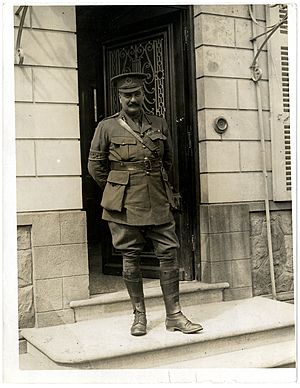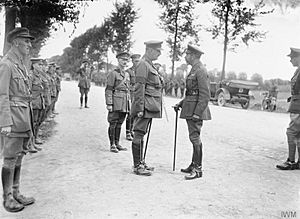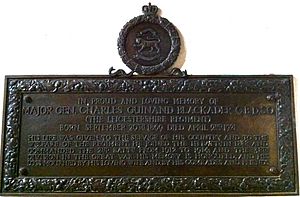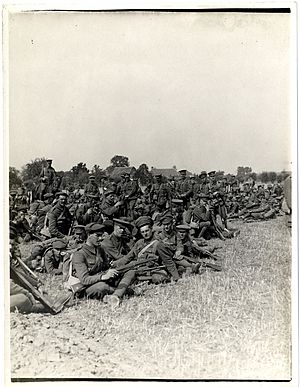Charles Blackader facts for kids
Quick facts for kids
Charles Guinand Blackader
|
|
|---|---|

Blackader at brigade headquarters in France, 24 July 1915
|
|
| Born | 20 September 1869 Richmond, Surrey, England, United Kingdom |
| Died | 2 April 1921 (aged 51) Millbank, City of Westminster, London, England, United Kingdom |
| Allegiance | |
| Service/ |
|
| Rank | Major-General |
| Unit | Leicestershire Regiment |
| Commands held | 2nd Leicestershire Regiment 20th (Garhwal) Brigade 177th Brigade 38th (Welsh) Division Southern District, Irish Command |
| Battles/wars | Second Boer War First World War |
| Awards | Companion of the Order of the Bath Distinguished Service Order Commander of the Order of Leopold |
Major-General Charles Guinand Blackader (20 September 1869 – 2 April 1921) was an important officer in the British Army during the First World War. He led an Indian army unit on the Western Front in 1915. He also commanded a local army unit in Dublin during the Easter Rising in 1916. Later, he was put in charge of the 38th (Welsh) Division on the Western Front. He kept this role until he had to retire in May 1918 because of poor health.
Blackader joined the Army in 1888 as a young officer. His first active duty was in West Africa, followed by service in the Boer War. There, he led a company during the defence of Ladysmith. He was known for being good at organizing and managing things. For the next ten years, he commanded various smaller army posts. Eventually, he took command of the 2nd Battalion, Leicestershire Regiment, in 1912. When the First World War began, he led his battalion in France. In 1915, he became the commander of a larger unit called a brigade. He led this brigade through major battles like the Battle of Neuve Chapelle and the Battle of Loos.
After the Indian army units left France, Blackader was sent to train a new army unit in the United Kingdom. In 1916, this unit went to Dublin during the Easter Rising. After the rebellion, Blackader was in charge of many military trials. Later that year, he went back to France to lead the 38th (Welsh) Division. This division had lost many soldiers in the Battle of the Somme. He stayed with the division for almost two years, helping to train and reorganize it. The division did very well in the Hundred Days Offensive of 1918. However, Blackader was no longer in command by then, as he had returned home due to illness. He died shortly after the war in 1921, at the age of 51.
Contents
Early Life and Army Start
Charles Guinand Blackader was born in Richmond, Surrey on 20 September 1869. His father was a teacher. Blackader studied at the Royal Military College, Sandhurst, which is a famous army training school. He was seen as a promising student.
In August 1888, he finished his training and joined the 1st Battalion, Leicestershire Regiment. Two weeks later, his battalion was sent to Bermuda. Blackader's trip was delayed because he got married in London. This was unusual for a young officer at that time.
Blackader and his wife lived in Bermuda for about a year and a half. Their first daughter, Dorothy, was born there in April 1889. In 1890, his battalion moved to Nova Scotia in Canada. He was promoted to lieutenant in March. Their second daughter, Joan, was born in April 1892. A year later, the battalion moved again, this time to the West Indies. Blackader became the adjutant, which meant he was in charge of the daily organization for part of the battalion in Jamaica. In late 1895, the battalion went to South Africa. Blackader returned to England and was promoted to captain in December.
Service in Africa
In late 1897, Blackader was sent to West Africa. He joined the West African Frontier Force, a new army group. He helped organize this force, and within six months, they were successful in stopping local slave traders. This was Blackader's first time in active combat. He was praised for his work and showed his skill in organizing.
He left West Africa in January 1899 because he was ill. Many officers there got sick, and Blackader caught malaria and dysentery. After six months of rest, he went to South Africa to lead a company of the 1st Leicesters.
Blackader's company saw action in the Second Boer War in October 1899. They fought at the Battle of Talana Hill and the Battle of Ladysmith. After the battle, Boer forces surrounded Ladysmith, starting a four-month siege. Blackader's battalion stayed in the town until the relief column arrived in February.
After the siege, his unit was stationed in Middelburg. Blackader was put in charge of the railway station and its coal mines in Witbank. He was praised twice during the war and received the Distinguished Service Order (DSO) for his bravery.
Life in India and England
In August 1902, Blackader became an adjutant for a volunteer battalion in Leicestershire. This job was mostly about organizing and training the local soldiers. In September 1904, he was promoted to major. A few months later, he went to India to join the regular 1st Battalion.
In India, he was put in charge of the army camp at the Purandhar Sanatorium. This was his fourth time in an administrative role in five years. He returned to England with his battalion at the end of 1906. Blackader enjoyed sports and social events during this time. He was promoted to lieutenant colonel in September 1912, taking command of a battalion.
First World War Service
When the First World War began in August 1914, Blackader was in India. He was leading the 2nd Battalion of the Leicesters. His unit was sent to France as part of the Indian Expeditionary Force A. They first saw action in the trenches on 29 October. On 19 December, Blackader led a successful attack on German trenches.
Leading the Garhwal Brigade
In January 1915, Blackader was made a temporary Brigadier-General. He took command of the Garhwal Brigade. This brigade led the first attack for the Indian Corps at the Battle of Neuve Chapelle on 10 March. Three of their battalions reached their goals. Two soldiers from his unit were awarded the Victoria Cross, the highest award for bravery. Blackader was praised by his commander, General Willcocks. However, his unit suffered heavy losses.
On 9 May, the Garhwal Brigade was part of the attacks at the Battle of Aubers Ridge, but they were not successful. They fought again on 15 May, but Blackader had to stop the attack due to strong enemy resistance.
After Aubers Ridge, the Indian Corps rested. In September, they fought in the Battle of Loos. Blackader's brigade was on the right side of the attack. While they crossed no-man's land successfully, part of the brigade got stuck in enemy wire. Only one battalion reached the German trenches. The Indian Corps was pulled out of France after this battle. This was Blackader's last major action leading Indian troops.
Duty in Ireland
In January 1916, Blackader was moved to command the 177th (2/1st Lincoln and Leicester) Brigade. This unit was part of the 59th (2nd North Midland) Division. This division was made up of soldiers who had not volunteered to fight overseas. They were mainly used for defending Britain.
The 59th Division was quickly sent to Ireland in April 1916 because of the Easter Rising. This was a rebellion against British rule. After the Rising, many people thought to be responsible were put on trial by the military. Blackader, as a senior officer, was in charge of several of these trials. This included the trials of important leaders of the rebellion. Blackader found this task very difficult. He reportedly said that he had to condemn "one of the finest characters" he had ever met.
Leading the Welsh Division

On 21 June, Blackader was told to go to France. On 9 July, he was chosen to take command of the 38th (Welsh) Division. This division had suffered many losses during the Battle of the Somme. Blackader officially took permanent command on 12 July, with the temporary rank of major-general.
The Welsh Division had been formed in 1914. Many of its officers had been chosen for political reasons, not always for their military skills. Under Blackader, who was an outsider, the division's performance greatly improved. He was able to remove officers who were not doing well. The division fought at Pilckem Ridge in 1917. From September 1917, they were kept in quieter areas. The division trained hard during this time. In April 1918, they were able to launch a successful attack, showing how much they had improved.

In late May 1918, Blackader was replaced by a younger officer, Thomas Cubitt. This was because Blackader had become ill. The commander, Douglas Haig, had said Blackader's work with the 38th Division was "excellent". Under Cubitt's command, the 38th Division used its training to fight very successfully in the Hundred Days Offensive. On 21 November 1918, Blackader was put in charge of the Southern District in Ireland. He served there until February 1920.
For his service in the war, he was made an aide-de-camp to the King in 1916. He also received the Companion of the Order of the Bath in 1917. He was given awards from Belgium and France as well.
Blackader died on 2 April 1921, at the age of 51. He passed away from liver cancer and heart failure. He was survived by his wife and two daughters. There is a memorial to him in the regimental chapel in Leicester Cathedral. His grave was later found at Putney Vale Cemetery.
Images for kids
-
King George V (centre-right) speaks with Blackader (centre-left) while visiting the division, 13 August 1916.
-
Memorial to Major General Charles Guinand Blackader in Leicester Cathedral








